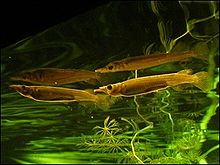- Wrestling halfbeak
-
Wrestling halfbeak 
Wrestling halfbeaks in an aquarium Scientific classification Kingdom: Animalia Phylum: Chordata Class: Actinopterygii Order: Beloniformes Family: Hemiramphidae Genus: Dermogenys Species: D. pusilla Binomial name Dermogenys pusilla
Kuhl & van Hasselt, 1823The wrestling halfbeak, Dermogenys pusilla, also known as Malayan halfbeak is a member of the halfbeak family (Hemiramphidae) found in the fresh and brackish waters of rivers and coastal regions in South-East Asia, in Singapore, Thailand, Indonesia, Thailand, Malaysia, Borneo and Sumatra.[1][2] It is a small, slender, livebearing fish, with the elongated lower jaw characteristic of its family. The colour of this species varies, depending on where the specimen is found.[3]
Wrestling halfbeaks are surface-feeding fish and feed on a variety of small invertebrates including crustaceans and insect larvae, but especially mosquito larvae and flying insects that have fallen onto the surface of the water.[4] As with all halfbeaks, the upper jaw lifts upwards when the fish is opening its mouth. Wrestling halfbeaks are livebearing fish, the females giving birth to around twenty offspring after a gestation period of about a month.[5][6][7]
Wrestling halfbeaks are sexually dimorphic. The females are larger than the males and grow up to 7 cm (2.8 inches) long; males only reach about 5.5 cm (2.2 inches) and typically has red or yellow patches on the dorsal fin and the beak.[8][9] The males of wrestling halfbeaks will fight among themselves by locking jaws, hence their name, for up to thirty minutes.
Contents
Fish fighting
In the wild, and in large aquaria, the weaker male will quickly disengage and swim away, and fights therefore rarely result in serious injury to either party. However, in their native range, local people sometimes use wrestling halfbeaks as fighting fish for betting purposes (like fighting cocks or siamese fighting fish).[10][11]
Wrestling halfbeaks in aquaria
Wrestling halfbeaks, as well as other species in the genus Dermogenys, are quite widely traded as aquarium fish, sometimes under the "silver halfbeak" or "golden halfbeak" names, depending on the colouration of the fish. As with all freshwater halfbeaks, these fish are sensitive to sudden changes in pH and hardness, but they are otherwise adaptable, and can be maintained in anything from soft and acid freshwater through to slightly brackish water.[12][13] When first introduced into the aquarium, wrestling halfbeaks are nervous fish that tend to be timid. They may swim frantically if suddenly frightened, even crashing into the walls. However, once they are used to their surroundings, they become lively, easy to care for fish.[14][15]
References
- ^ Froese, Rainer, and Daniel Pauly, eds. (2005). "Dermogenys pusilla" in FishBase. November 2005 version.
- ^ "Dermogenys pusilla". Integrated Taxonomic Information System. http://www.itis.gov/servlet/SingleRpt/SingleRpt?search_topic=TSN&search_value=616690. Retrieved 19 March 2006.
- ^ Schäfer F & M. Kemkes: All Livebearers and Halfbeaks, Aqualog 1998, ISBN 3-931702-77-4
- ^ "Pygmy Halfbeak". Archived from the original on 2006-05-07. http://web.archive.org/web/20060507201357/http://www.ecologyasia.com/verts/fresh-fishes/pygmy-halfbeak.htm. Retrieved 2006-09-03.
- ^ Meisner, A & Burns, J: Viviparity in the Halfbeak Genera Dermogenys and Nomorhamphus (Teleostei: Hemiramphidae). Journal of Morphology 234, pp 295-317, 1997
- ^ "Keeping & Breeding Halfbeaks". http://homepage.mac.com/nmonks/aquaria/halfbeakbreeding.html. Retrieved 2006-09-03.
- ^ Earl Blewett. "Dermogenys pusillus - The Wrestling Halfbeak Livebearer". http://okcaa.org/articles/Blewett%20Dermogenys%20pusillus.pdf#search=%22breeding%20dermogenys%20pdf%22. Retrieved 2006-09-03.
- ^ Riehl R. & Baensch H: Aquarium Atlas (vol. 1), Voyageur Press, 1996, ISBN 3-88244-050-3
- ^ Riehl R. & Baensch H: Aquarium Atlas (vol. 2), Microcosm Ltd, 1997, ISBN 1-890087-06-8
- ^ "Freshwater Fishes and the Singaporean". http://habitatnews.nus.edu.sg/guidebooks/freshfish/text/105.htm. Retrieved 2007-01-25.
- ^ Sterba, G: Freshwater Fishes of the World, p. 609, Vista Books, 1962
- ^ "Halfbeaks By Roger Fischer". Aqua News. January/February 1994. Archived from the original on 2006-05-15. http://web.archive.org/web/20060515214402/http://www.mn-aquarium.org/masart23.htm. Retrieved 2006-09-03.
- ^ Monks N. (editor): Brackish Water Fishes, TFH 2006, ISBN 0-7938-0564-3
- ^ Monks N: Straight to the point: the Beloniformes. Practical Fishkeeping, October 2005
- ^ Monks N: Life at the Top. Tropical Fish Hobbyist, November 2006
See also
Categories:- Hemiramphidae
- Live-bearing fish
- Viviparous fish
- Fishkeeping
- Fish of Bangladesh
Wikimedia Foundation. 2010.
